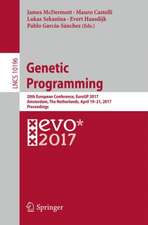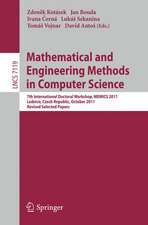Evolvable Components: From Theory to Hardware Implementations: Natural Computing Series
Autor Lukas Sekaninaen Limba Engleză Hardback – 23 oct 2003
| Toate formatele și edițiile | Preț | Express |
|---|---|---|
| Paperback (1) | 328.27 lei 6-8 săpt. | |
| Springer Berlin, Heidelberg – 3 oct 2013 | 328.27 lei 6-8 săpt. | |
| Hardback (1) | 336.54 lei 6-8 săpt. | |
| Springer Berlin, Heidelberg – 23 oct 2003 | 336.54 lei 6-8 săpt. |
Din seria Natural Computing Series
- 20%
 Preț: 507.38 lei
Preț: 507.38 lei - 20%
 Preț: 305.91 lei
Preț: 305.91 lei - 20%
 Preț: 992.26 lei
Preț: 992.26 lei - 20%
 Preț: 617.14 lei
Preț: 617.14 lei - 20%
 Preț: 645.47 lei
Preț: 645.47 lei - 20%
 Preț: 642.65 lei
Preț: 642.65 lei - 20%
 Preț: 998.04 lei
Preț: 998.04 lei - 18%
 Preț: 963.60 lei
Preț: 963.60 lei - 20%
 Preț: 655.20 lei
Preț: 655.20 lei - 20%
 Preț: 615.70 lei
Preț: 615.70 lei - 20%
 Preț: 645.65 lei
Preț: 645.65 lei - 20%
 Preț: 640.19 lei
Preț: 640.19 lei - 20%
 Preț: 655.02 lei
Preț: 655.02 lei -
 Preț: 384.70 lei
Preț: 384.70 lei - 20%
 Preț: 652.54 lei
Preț: 652.54 lei - 20%
 Preț: 649.28 lei
Preț: 649.28 lei - 20%
 Preț: 330.75 lei
Preț: 330.75 lei - 20%
 Preț: 328.09 lei
Preț: 328.09 lei -
 Preț: 389.70 lei
Preț: 389.70 lei - 20%
 Preț: 644.66 lei
Preț: 644.66 lei - 20%
 Preț: 333.88 lei
Preț: 333.88 lei - 20%
 Preț: 1299.31 lei
Preț: 1299.31 lei - 20%
 Preț: 528.47 lei
Preț: 528.47 lei - 20%
 Preț: 648.11 lei
Preț: 648.11 lei - 15%
 Preț: 639.90 lei
Preț: 639.90 lei - 20%
 Preț: 322.43 lei
Preț: 322.43 lei - 20%
 Preț: 657.83 lei
Preț: 657.83 lei - 20%
 Preț: 659.31 lei
Preț: 659.31 lei - 20%
 Preț: 997.56 lei
Preț: 997.56 lei - 20%
 Preț: 508.61 lei
Preț: 508.61 lei -
 Preț: 400.85 lei
Preț: 400.85 lei - 20%
 Preț: 653.38 lei
Preț: 653.38 lei - 20%
 Preț: 308.60 lei
Preț: 308.60 lei - 20%
 Preț: 654.05 lei
Preț: 654.05 lei - 15%
 Preț: 652.17 lei
Preț: 652.17 lei - 20%
 Preț: 656.19 lei
Preț: 656.19 lei
Preț: 336.54 lei
Preț vechi: 420.67 lei
-20% Nou
Puncte Express: 505
Preț estimativ în valută:
64.40€ • 68.86$ • 53.69£
64.40€ • 68.86$ • 53.69£
Carte tipărită la comandă
Livrare economică 18 aprilie-02 mai
Preluare comenzi: 021 569.72.76
Specificații
ISBN-13: 9783540403777
ISBN-10: 3540403779
Pagini: 212
Ilustrații: XVI, 195 p.
Dimensiuni: 155 x 235 x 17 mm
Greutate: 0.53 kg
Ediția:2004
Editura: Springer Berlin, Heidelberg
Colecția Springer
Seria Natural Computing Series
Locul publicării:Berlin, Heidelberg, Germany
ISBN-10: 3540403779
Pagini: 212
Ilustrații: XVI, 195 p.
Dimensiuni: 155 x 235 x 17 mm
Greutate: 0.53 kg
Ediția:2004
Editura: Springer Berlin, Heidelberg
Colecția Springer
Seria Natural Computing Series
Locul publicării:Berlin, Heidelberg, Germany
Public țintă
ResearchCuprins
1 Introduction.- 1.1 Natural Computing.- 1.2 Bioinspired Hardware.- 1.3 Motivation for Research.- 2 Reconfigurable Hardware.- 2.1 Digital Cicuits.- 2.2 Digital Circuit Design.- 2.3 Field Programmable Gate arrays.- 2.4 Hardware Reused as Software.- 2.5 Reconfigurable Computing.- 2.6 Nanotechnology.- 2.7 Cell Matrix.- 2.8 Summary.- 3 Evolutionary Algorithms.- 3.1 Introduction.- 3.2 Variant of Evolutionary Algorithms.- 3.3 Some Other Features of Evolutionary Algorithms.- 3.4 Evolutionary Design and Optimization.- 3.5 The Evolutionary Algorithm Design.- 3.6 Formal Approach.- 3.7 Summary.- 4 Evolvable Hardware.- 4.1 Basic Concept.- 4.2 Cartesian Genetic Programming.- 4.3 Features of Cartesian Genetic Programming.- 4.4 From Chromosome to Fitness Value.- 4.5 Fitness Function.- 4.6 Applications and Degree of Hardware Implementation.- 4.7 Promising Results.- 4.8 Major Current Problems and Potential Solutions.- 4.9 Summary.- 5 Towards Evolvable Components.- 5.1 Component Approach to Problem Solving.- 5.2 Evolvable Components.- 5.3 Hardware Implementation.- 5.4 Extension of Evolvable Components.- 5.5 Summary.- 6 Evolvable Computational Machines.- 6.1 Computational Machines and Evolutionary Design.- 6.2 Cellular Automata.- 6.3 General Evolvable Computational Machine.- 6.4 Dynamic Environment.- 6.5 Evolvable Computational System.- 6.6 Properties of Evolvable Machines.- 6.7 The Computational Power.- 6.8 Summary.- 7 An Evolvable Component for Image Pre-processing.- 7.1 Motivation and Problem Specification.- 7.2 The Image Filter Design.- 7.3 Analysis of Reconfigurability and Size of the Search Space.- 7.4 Evolutionary Design: Experimental Framework.- 7.5 Filters for Smoothing.- 7.6 Other Image Operators.- 7.7 Dynamics Environment.- 7.8 A Note on a Single Filter Design.- 7.9 Summary.- Virtual Reconfigurable Devices.- 8.1 Chip on Top of a Chip.- 8.2 Architecture of Virtual Reconfigurable Circuits.- 8.3 Implementation Costs.- 8.4 Speeding up the Evolutionary Design.- 8.5 Genetic Unit.- 8.6 Physical Realization.- 8.7 Discussion.- 8.8 Summary.- 9 Concluding Statements.- 9.1 The Approach.- 9.2 The Obtained Results.- 9.3 Future Work.- References.
Recenzii
From the reviews:
"This monograph gathers in one volume methods for evolvable hardware design with underlying and supporting fields and theories like soft computing, evolutionary biology and generalizations of computational machines. … The book may serve very well as handbook for courses on evolvable systems." (Antoni Michalski, Zentralblatt MATH, Vol. 1056, 2005)
"This monograph gathers in one volume methods for evolvable hardware design with underlying and supporting fields and theories like soft computing, evolutionary biology and generalizations of computational machines. … The book may serve very well as handbook for courses on evolvable systems." (Antoni Michalski, Zentralblatt MATH, Vol. 1056, 2005)
Notă biografică
Lukas Sekanina received MSc degree in Computer Science and Engineering and PhD degree in Information Technology from Brno University of Technology, Czech Republic, in 1999 and 2002 , respectively. He was a visiting lecturer with Pennsylvania State University, USA, and a visiting researcher with Department of Informatics, University of Oslo, Norway, in 2001. He is author or co-author of more than 20 refereed conference papers mainly on evolvable hardware and bio-inspired computing. He was awarded Siemens Awards 1999 and 2000 and The best paper award at IEEE Design and Diagnostics of Electronic Circuits and System workshop 2002. Currently he is an assistant professor with Faculty of Information Technology, Brno University of Technology. His research interests focus on theory, design and implementations of bio-inspired computational systems.
Caracteristici
Provides new insights to the theory, software implementations and hardware realizations of evolvable systems Includes supplementary material: sn.pub/extras



















